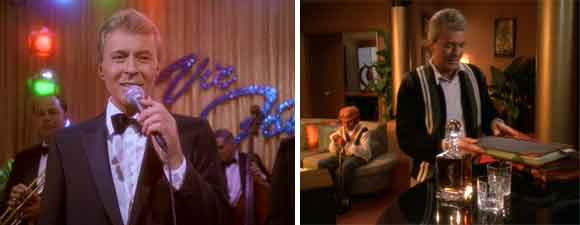Retro Review: Captive Pursuit
6 min readDeep Space Nine becomes the site of a struggle between the captive Tosk, bred to be hunted, and those who pursue him for sport.
Plot Summary: An unidentified vessel comes through the wormhole with a single passenger, a reptilian alien who seems more concerned about escape than allowing his damaged ship to be repaired. O’Brien tractors the ship to safety at the station but finds the alien Tosk secretive and suspicious, though thankful for O’Brien’s kindness. Tosk requires little food or sleep and is constantly on the defensive, which makes Sisko concerned that he’s on the run. Not long afterward, Odo catches Tosk sabotaging a security grid near the station’s weapons storage and locks him up. While Tosk is incarcerated, another ship arrives and beams aboard a group of aliens who immediately open fire as they fight their way to the brig. They capture Tosk and explain that he has been bred to be their prey, but since the hunt has been unsatisfying, they will take him home alive to be humiliated. Sisko condemns the blood sport but tells O’Brien that the noninterference directive forbids him from keeping Tosk safe on the station unless Tosk asks for asylum, which Tosk refuses to do because his culture would consider that even greater humiliation. After a conversation with Quark about Ferengi disregard for rules, O’Brien discards his comm badge and modifies a security barrier so that when the lead hunter tries to take Tosk through it, the hunter is injured. Then O’Brien takes Tosk to his ship to escape while Sisko – who officially condemns this violation of orders – suggests that Odo not make an effort to prevent the getaway.
Analysis: “Captive Pursuit” isn’t a particularly original idea. The hunter-prey sci-fi storyline here reminds me of Roger Zelazny’s novel Eye of Cat as well as the original Star Trek’s “The Gamesters of Triskelion” minus the betting. In fact, this episode could have taken place on any of the starship-based Star Trek series; the fact that Tosk and his pursuers come through the wormhole from the Gamma Quadrant makes the crew initially more cautious in dealing with them, but also makes the stakes seem lower than if they’d been on a planet near Federation space. So it is baffling to me that Sisko cites the Prime Directive for not putting a stop to the hunt, something I can’t imagine either Kirk or Picard doing. The non-interference directive might prevent Sisko from sending a ship out into space to interfere with a fight in progress, but this hunt has come to a Federation facility where the warp-capable spacefaring aliens arrive with weapons drawn. Sisko would not be forcing his values upon the aliens by refusing to surrender Tosk to their custody, but upholding the laws of the station under his command. If Tosk wanted to take his own ship and return willingly with his captors because he believed that to be his duty, that would be a different story, but the fact that Tosk does not want to request asylum and stay under Starfleet protection indefinitely clearly does not mean that he’s ready to go without a fight.
So I’m not very impressed with this episode, particularly as a vehicle for learning about Sisko, whose actions would alarm me a great deal were I a onetime Bajoran terrorist whom the Cardassians might wish to arrest or even a sleaze like Quark (though apparently sexual harassment is taken little more seriously in the 24th century than it is now, considering that Sisko seems more bemused than outraged when a Dabo girl tells him that Quark insists that she provide sexual services as part of her contract to work in his bar). It’s a much better episode for O’Brien, whom we’ve seen thus far primarily in relationship to his family and his engineering job. Here we are reminded that he was always quite social on Picard’s Enterprise, making friends easily, reaching out to people who didn’t quite fit in. The fact that Tosk has no sense of humor doesn’t stop O’Brien from cracking jokes, trying to put him at ease, inquiring about Tosk’s situation not to be nosy but because he wants to help. Though he sees much more of Tosk’s suspicious behavior, he’s not instantly on guard like Odo and to some extent like Sisko. He does a much better job than Sisko here of embodying the Federation principles governing first contacts.
It’s very telling that O’Brien’s most helpful advice comes from his dealings not with his fellow Starfleet officers, but with Kira and Quark. As it was with Tahna Los when Kira negotiated amnesty for former terrorists with the Bajoran provisional government, her first thought here is to persuade the highest authority to grant amnesty to the prisoner, and Sisko readily agrees that he will do so if asked, though it’s odd that neither he nor O’Brien came up with the possibility himself given that it’s the Federation which offers such a protection of rights. (It would be interesting if Kira refused to let Sisko grant custody of Tosk to his hunters citing Bajoran law, which we already know doesn’t permit Cardassians or their agents to pursue anyone into Bajoran space.) Quark doesn’t offer advice so much as act as a sounding board for O’Brien, which he says is what a good bartender should do, though he objects to being called “Barkeep” rather than “Proprietor” – the positive side of Quark’s apparently being outside Federation law is that he can encourage Starfleet officers to consider actions that go against their rules, though one hopes that doesn’t extend to harassing women at the gambling tables.
Sisko may not be a strong presence as a commander during this outing, but at least he knows when to shut up and sit back. I believe Picard would have done more to protect Tosk, but I also believe that Picard would have disciplined O’Brien for taking off his comm badge and disobeying orders, while Sisko gives him a thirty-second warning and smiles when O’Brien observes that someone in high places must have made a decision not to lock down the station to prevent Tosk’s escape. Odo, who tends to see justice in absolute terms regardless of laws and morals, is ready to pursue Tosk not necessarily because he thinks it’s the right thing to do, but because he can’t fathom permitting a lapse in security or even the appearance of one, but Sisko is in some ways as willing as O’Brien to get the desired outcome with some bending of regulations. That makes up for a lot of his apparent short-sightedness earlier on. We see some precedents here for how Sisko will later deal with the Jem’Hadar, the genetically bred warriors of the Dominion, who are also raised to believe that obsessive loyalty to their masters and an honorable death are the only things that truly matter. The Jem’Hadar also have reptilian features, incredible stamina, a single source of nutrition, and personal cloaking shields, so perhaps they are meant to be a related species to Tosk. Without any other continuity, this becomes a rather forgettable episode, unfortunately.







Interestingly, I’ve always assumed Tosk was somehow related to the JemHadar as well.
I always liked this episode… a good O’Brien episode that shows his compassionate side… he was always seen as a bit harsh and bigoted against the “Cardies’ during his time on the Enterprise…
Real world, I would tend to imagine the explanation for how Sisko is written in this episode is simply that neither the writers nor the actor have quite nailed him down yet. But in universe I think that this episode is actually very good. One of the main themes I think most would agree is Sisko’s spiritual development. Right now in these earliest of days he is relying on his intellect. He is doing what he “thinks” is the right thing to do. Later in the episode he is willing to trust his instincts enough to give quiet aid to O’Brien. In later years as Sisko grows more and more into himself we will see a man who is more than willing to ignore Starfleet regulations when they conflict with what he believes to be the right thing to do.
In some ways I’m actually glad for this episode. One of the biggest problems with most Trek is a tendency to have characters start perfect and just get more perfecter with every episode. I like things like Sisko being a bit unsure about stepping away from regs, or Bashir being an insufferable little snot. It makes it more interesting when they start to grow.
As for this being an excellent showcase for O’Brien, I couldn’t agree more. One of the things that I liked well enough about his appearences on TNG and loved about him on DS9, was that it showed that by the 24th century there was clearly a return to the old fashioned idea of respecting someone who knows things and applies that knowledge effectively, regardless of how they come by that knowledge (so long as it’s moral). There’s never a moment in either series where O’Brien is looked down upon because he isn’t an Academy graduate. Instead he is valued and respected for his skills, and his work ethic. In many ways I view O’Brien as the face of the working class in the 24th century and I’m always delighted anytime he is focused upon.